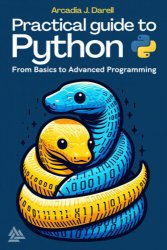Practical Guide to Python: From Basics to Advanced Programming
- Добавил: literator
- Дата: 28-08-2024, 16:02
- Комментариев: 0
 Название: Practical Guide to Python: From Basics to Advanced Programming
Название: Practical Guide to Python: From Basics to Advanced ProgrammingАвтор: Arcadia J. Darell
Издательство: Arcadia J. Publishing
Год: 2024
Страниц: 365
Язык: английский
Формат: pdf, epub (true), mobi
Размер: 10.1 MB
This book offers a comprehensive path to learning Python, starting from the basics and progressing to more complex concepts and practical applications. It is designed for anyone looking to gain a solid understanding of the Python language, whether they are complete beginners or experienced programmers seeking to deepen their skills.
Python is a high-level programming language known for its readability and simple syntax. One of Python's main goals is to make code easy to read. This is achieved through clear and concise syntax that uses indentation to define code blocks, avoiding the use of curly braces or keywords like "begin" and "end." Code readability facilitates maintenance and collaboration among developers, reducing the likelihood of errors and improving so ware quality.
Python aims to minimize code complexity, allowing programmers to write efficient code in less time. Python's simple and intuitive syntax allows complex concepts to be expressed in a few lines of code. This increases developer productivity by allowing them to focus on application logic rather than language details.
Python is designed to be a cross-platform language, meaning that Python code can run on a wide range of operating systems without modification. Python is available on numerous platforms, from desktops to servers to mobile devices. Python's portability makes it an ideal choice for developing applications that need to run in different environments.
Python is highly extensible, meaning it can easily be integrated with other languages and systems, such as C, C++, and Java. This flexibility makes Python ideal for a wide range of applications, from web development to data science. Extensions allow critical parts of the code to be optimized for better performance or to leverage existing libraries written in other languages.
Numerous frameworks and libraries have been developed for Python, extending its use in areas such as web development (Django, Flask), Data Science (NumPy, Pandas, Matplotlib), Machine Learning (TensorFlow, Scikit-learn), and many others. These tools have made Python a popular choice for a wide range of applications, from web development to scientific research.
Main contents:
- **Introduction to Python**: Familiarization with the syntax and core features of the language. Setting up the development environment.
- **Data Structures and Control Flow**: Working with lists, dictionaries, sets, and tuples. Implementing loops and conditions.
- **Functions and Modules**: Creating and using functions. Organizing code with modules and packages.
- **Object-Oriented Programming (OOP)**: Defining classes and objects. Concepts of inheritance, encapsulation, and polymorphism.
- **Exception Handling**: Using try-except to handle errors and exceptions.
- **Web Development**: Introduction to frameworks like Flask and Django for building web applications.
- **Data Science and Machine Learning**: Data analysis with Pandas and NumPy. Building machine learning models with Scikit-learn.
- **Automation and Scripting**: Automating daily tasks with Python scripts.
Objective of the book: The aim of this book is to provide readers with a practical and accessible guide to mastering Python and applying it across various fields of technology. With practical examples and exercises, readers will be able to develop real-world applications and solve complex problems using Python.
Скачать Practical Guide to Python: From Basics to Advanced Programming
[related-news] [/related-news]
Внимание
Уважаемый посетитель, Вы зашли на сайт как незарегистрированный пользователь.
Мы рекомендуем Вам зарегистрироваться либо войти на сайт под своим именем.
Уважаемый посетитель, Вы зашли на сайт как незарегистрированный пользователь.
Мы рекомендуем Вам зарегистрироваться либо войти на сайт под своим именем.
